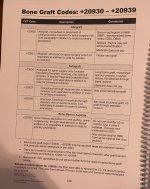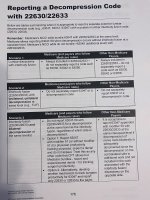This is exactly what the doctor has in the note (save for a spelling correction or two).
Surgeon: Dr. S.
1st Assistant Surgeon: Dr. W.
2nd Assistant Surgeon: Dr. K.
POSTOPERATIVE DIAGNOSIS:
L4-5 Lumbar disc herniation with radiculopathy: M51.16
Medically refractory lumbago worse on the right side with evidence of progressive right sided L4-5 disc collapse and endplate abnormalities: M51.26
Symptoms above secondary to significant motor vehicle collision: V87.8XXA
PROCEDURE (Codes listed below description)
Posterior lumbar spine approach for:
Right L4-5 hemilaminectomy, facetectomy, discectomy
L4-5 Transforaminal lumbar interbody fusion at right L4-5
Bilateral pedicle screw placement at L4-5
Nonsegmental instrumentation system using the Globus lumbar fusion system at L4-L5
Placement of interbody cage at L4-5 for fusion purposes
Use or morselized bone graft material inside the cage and interbody space as well as posterior lateral gutters for fusion purposes
Use of intraoperative 3-D imaging with the Siemens Cios-spin
Use of intraoperative microscope
Use of intraoperative neuro monitoring
ANESTHESIA: General.
ADVERSE EVENTS: None noted.
TIMEOUT: Observed.
PREOPERATIVE NOTE: The patient is an adult female with post-MVC related lumbar disc herniation with radiculopathy and chronic medically refractory lumbago. She actually also underwent numerous injections as well as a percutaneous discectomy last year, with unfortunately no sustainable relief of her symptoms. Patient had tried and failed all forms of conservative management including medical therapy, physical therapy, and injections as previously mentioned. The risks, benefits, options, expected and potential outcomes regarding surgery were discussed in detail with the patient, and the patient voiced understanding and freely agreed to proceed with surgical plan as stated above.
OPERATIVE NOTE: The patient was taken to the operative theater and was carefully and gently intubated by Anesthesia. Patient was then placed prone on the operating table, taking great care to avoid undue all pressure points. The lumbar & sacral area was then prepped and draped. A timeout was observed to confirm the patient, the procedure, and the surgical plan. Prior to skin incision, we obtained a 3-D intraoperative scan to verify adequate positioning and alignment. We intended to use the Augmedics system, but registration would not cooperate. We then introduced the x-ray machine back into the field and placed the bilateral guidewires into L4 and L5 in a transpedicular fashion. This was also done using neuro monitoring. At this point a right-sided paramedian incision was demarcated and infiltrated with local anesthetic. A retractor was in place for exposure. The right L4-5 medial facet as well as lamina was drilled using a high-speed bur. The marked scope was introduced in the field and under further microsurgical guidance, the interspace was entered. It was quite tight at this level on the right side so it was gradually opened using sequential shavers. Copious amounts of disc material was removed in routine fashion. Once the endplates are prepared in usual fashion, a trial implant was inserted and noted to be a nice fit. We then placed and a final morselized bone graft material in the contralateral space for the interbody fusion. We then placed the interbody cage at L4-L5 and gradually elevated it to approximately a height of 10mm. This provided a very nice restoration of the lordosis and height loss along with coronal instability at that level. We then stabilized by placement of the bilateral pedicle screws over the guidewires at L4 and L5 in routine fashion. We tested all the screws and they were testing above normal limits. We obtained a repeat 3-D run and decided to revise the right L5 screw to make it more optimal. This was done without incident. At this point rods were placed over L4 and L5 and locking caps were applied. Final fixation was performed. Copious amounts of antibiotic irrigation were then placed. Meticulous hemostasis was achieved. The retractor was then removed, and a multilayer closure was then performed. Once the retractors were removed, a multilayer closure was performed followed by skin glue.
The patient tolerated the procedure well, was placed supine on the OR stretcher, extubated, and taken to the recovery room in stable condition. Prior to closure of the skin, all needle, thread, and sponge counts were correct x3. The patient was extubated and recovered quite nicely. The utilization of the MD and certified first assist in the operating room was essential to the timely and safe completion of the surgery. They specifically assisted with positioning, prepping/draping, exposure, retraction, and facilitation of the surgical equipment, as well as closure and stabilizing patient to the recovery room. The use of intraoperative monitoring was crucial for the safety of the case since it has been shown to decrease the risk of perioperative unintentional neural compromise/deficits.
22630
63030-51-RT
22840
22853
69990
20937
I checked the Work RVU Calculator for the order the codes should go in and this was what it looked like.
Surgeon: Dr. S.
1st Assistant Surgeon: Dr. W.
2nd Assistant Surgeon: Dr. K.
POSTOPERATIVE DIAGNOSIS:
L4-5 Lumbar disc herniation with radiculopathy: M51.16
Medically refractory lumbago worse on the right side with evidence of progressive right sided L4-5 disc collapse and endplate abnormalities: M51.26
Symptoms above secondary to significant motor vehicle collision: V87.8XXA
PROCEDURE (Codes listed below description)
Posterior lumbar spine approach for:
Right L4-5 hemilaminectomy, facetectomy, discectomy
L4-5 Transforaminal lumbar interbody fusion at right L4-5
Bilateral pedicle screw placement at L4-5
Nonsegmental instrumentation system using the Globus lumbar fusion system at L4-L5
Placement of interbody cage at L4-5 for fusion purposes
Use or morselized bone graft material inside the cage and interbody space as well as posterior lateral gutters for fusion purposes
Use of intraoperative 3-D imaging with the Siemens Cios-spin
Use of intraoperative microscope
Use of intraoperative neuro monitoring
ANESTHESIA: General.
ADVERSE EVENTS: None noted.
TIMEOUT: Observed.
PREOPERATIVE NOTE: The patient is an adult female with post-MVC related lumbar disc herniation with radiculopathy and chronic medically refractory lumbago. She actually also underwent numerous injections as well as a percutaneous discectomy last year, with unfortunately no sustainable relief of her symptoms. Patient had tried and failed all forms of conservative management including medical therapy, physical therapy, and injections as previously mentioned. The risks, benefits, options, expected and potential outcomes regarding surgery were discussed in detail with the patient, and the patient voiced understanding and freely agreed to proceed with surgical plan as stated above.
OPERATIVE NOTE: The patient was taken to the operative theater and was carefully and gently intubated by Anesthesia. Patient was then placed prone on the operating table, taking great care to avoid undue all pressure points. The lumbar & sacral area was then prepped and draped. A timeout was observed to confirm the patient, the procedure, and the surgical plan. Prior to skin incision, we obtained a 3-D intraoperative scan to verify adequate positioning and alignment. We intended to use the Augmedics system, but registration would not cooperate. We then introduced the x-ray machine back into the field and placed the bilateral guidewires into L4 and L5 in a transpedicular fashion. This was also done using neuro monitoring. At this point a right-sided paramedian incision was demarcated and infiltrated with local anesthetic. A retractor was in place for exposure. The right L4-5 medial facet as well as lamina was drilled using a high-speed bur. The marked scope was introduced in the field and under further microsurgical guidance, the interspace was entered. It was quite tight at this level on the right side so it was gradually opened using sequential shavers. Copious amounts of disc material was removed in routine fashion. Once the endplates are prepared in usual fashion, a trial implant was inserted and noted to be a nice fit. We then placed and a final morselized bone graft material in the contralateral space for the interbody fusion. We then placed the interbody cage at L4-L5 and gradually elevated it to approximately a height of 10mm. This provided a very nice restoration of the lordosis and height loss along with coronal instability at that level. We then stabilized by placement of the bilateral pedicle screws over the guidewires at L4 and L5 in routine fashion. We tested all the screws and they were testing above normal limits. We obtained a repeat 3-D run and decided to revise the right L5 screw to make it more optimal. This was done without incident. At this point rods were placed over L4 and L5 and locking caps were applied. Final fixation was performed. Copious amounts of antibiotic irrigation were then placed. Meticulous hemostasis was achieved. The retractor was then removed, and a multilayer closure was then performed. Once the retractors were removed, a multilayer closure was performed followed by skin glue.
The patient tolerated the procedure well, was placed supine on the OR stretcher, extubated, and taken to the recovery room in stable condition. Prior to closure of the skin, all needle, thread, and sponge counts were correct x3. The patient was extubated and recovered quite nicely. The utilization of the MD and certified first assist in the operating room was essential to the timely and safe completion of the surgery. They specifically assisted with positioning, prepping/draping, exposure, retraction, and facilitation of the surgical equipment, as well as closure and stabilizing patient to the recovery room. The use of intraoperative monitoring was crucial for the safety of the case since it has been shown to decrease the risk of perioperative unintentional neural compromise/deficits.
22630
63030-51-RT
22840
22853
69990
20937
I checked the Work RVU Calculator for the order the codes should go in and this was what it looked like.
Last edited by a moderator:

